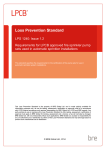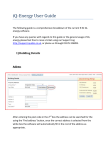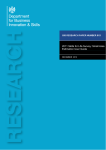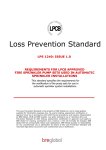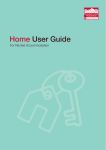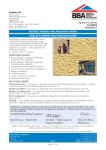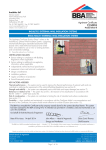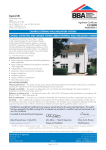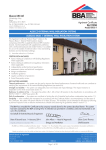Download Bre TechnicaL updaTe
Transcript
BRE Technical Update Topics this issue: L aunch of the Life Long Learning programme for HIs and DEAs • Why is it important • Where and how should I record my life long learning • Can other material count towards my life long learning • When should I return my life long programme QSAP software and EPC lodgement procedures guidance 1 Assessment good practice 2 Software data entry 3 Review of ‘draft’ PDF 4 Lodgement of the EPC 5 Need for revision - creating a duplicate RdSAP FAQs of the Month • Heating and Hot water • Dwelling Details • Recommendations Issue 001 - June 2008 Launch of the Life Long Learning programme for HIs and DEAs BRE are pleased to issue guidance and suggested materials to assist with the requirement for Life Long Learning (see the link in the Members’ Area of our websites www.breassessor.co.uk). It is essential to keep up to date with developments in your profession in order to always give the best and most professional service to your clients. Almost all professions have this requirement and Energy Assessors and Home Inspectors are no exception. It is also a requirement of the Scheme Standards set by Communities and Local Government that members undertake life long learning and CLG will audit schemes to make sure that members are up to date with this. BRE have now set guidance and identified qualifying material for your life long learning. You should have received a copy of your life long learning record form together with guidance notes via email. This information and the forms are additionally available from the BRE members’ area (www.breassessor.co.uk). The material provided for your life long learning is sufficiently varied to cover a wide selection of relevant information which we believe are relevant in keeping your understanding, knowledge and skills up to date in the industry. Please visit the members area of www.breassessor.co.uk (DEA) or www.breinspector.co.uk (HI) where you can find guidance on BRE’s Lifelong learning programme. THE LIFE LONG LEARNING PROGRAMME Contacts: HI/DEA Accreditation Scheme Manager Bucknalls Lane, Garston Watford WD25 9XX T: 0845 863 0014 E: [email protected] E: [email protected] www.breglobal.co.uk THE LIFE LONG LEARNING PROGRAMME IS AN ESSENTIAL PART OF YOUR MEMBERSHIP AND IS REQUIRED TO ENSURE THAT YOU MAINTAIN THE KNOWLEDGE AND UNDERSTANDING REQUIRED BY THE NATIONAL OCCUPATIONAL STANDARDS, EVERY MEMBER WILL NEED TO UNDER TAKE LIFE LONG LEARNING PROGRAMME AS PART OF THEIR CONTINUED MEMBERSHIP. GUIDANCE NOTES Why is it important to maintain knowledge and understanding? It is essential to keep up to date with developments in your profession in order to always give the best and most professional service to your clients. Almost all professions have this requirement and Energy assessors and Home Inspectors are no exception. It is also a requirement of the Scheme Standards set by Communities and Local Government that members undertake life long learning and CLG will audit schemes to make sure that members are up to date with this. Please record the date when the life long learning was carried out on www.homeinformationpacks.gov.uk the life long learning record together with the details of the learning Your Life long learning can be achieved by a number of means including distance learning, approved reading and attendance at approved courses. We will generally accept life long learning awards from other approved sources providing they are relevant, of appropriate quality and providing you can demonstrate that you achieved the requirement. In www.breassessor.co.uk Where and how should I record my life long learning undertaken. When fully complete send the record by email to cpd@ breassessor.co.uk Please do not send by post. Can other material count towards my life long learning BRE Technical Update Energy Efficiency Rating Very energy efficient – lower running costs 92-100 81-91 69-80 55-68 39-54 21-38 0-20 A B C Current Potential D 60 E 45 F G Not energy efficient – Higher running costs EU Directive 2002/91/EC Know and follow the most up-to-date version of the Quest User Manual and the BRE EPC training manual – both are in the Members’ Areas of our website. issue 001 - june 2008 QSAP software and EPC lodgement procedures guidance 1 Assessment good practice • Assess instruction to determine if property/dwelling requires an EPC – see CLG guidance on HIP exceptions (www.homeinformationpacks.gov.uk/industry/54_home.html) and the “Sale of more than one dwelling” (www.breassessor.co.uk). • Use of pre-printed site notes form(s), Quest or your own, if not using a hand-held electronic device. Ensure your site notes form or field software is updated as the QSAP software is updated. • Produce site based sketch layout plans of every level of the dwelling annotated with relevant details (e.g. function of each room, presence of radiators, TRVs and/or secondary heating). • Take and retain relevant external and internal colour photographs, sufficient for a third party to understand the dwelling – see guidance on photographs in the members’ area (www.breassessor.co.uk). 2 Software data entry • Review your site notes, layout plans and photographs to ensure you have all the relevant information and an accurate understanding of the dwelling. • Know and follow the most up-to-date version of the Quest User Manual and the BRE EPC training manual - both are in the Members’ Areas of our website. • Transfer relevant information from site notes accurately or if using a hand-held device, check the data has been uploaded correctly. • Ensure you enter the ‘Inspection Date’ accurately, ensuring you have the correct month and year as well as the day. Additional checks are now in place to validate this date field, but these are not exhaustive. • Complete the ‘Related party disclosure’ field when relevant. This should include any family, business or financial relationships or ties. It would not normally be appropriate for a HI or DEA to produce an EPC for a property they owned or that was owned by close family member or business partner/associate. • Under no circumstances should the ‘Date built’ field or the ‘Lowest occupied floor - Floor area (m2)’ field, for the main and any relevant extension/addition(s), be left blank. The software will assume that the whole part, including any upper floor(s), does not exist. • Review the suggested improvement options, particularly if the property is listed or within a conservation area, to ensure that options are appropriate (e.g. double glazing may not be allowed on a listed property). Delete options as necessary. • Ensure you enter the ‘Floor area (m2)’, ‘Room height (m)’ and ‘Heat loss perimeter (m)’ accurately, (to 2 decimal places) and in the correct order for each relevant floor, for the main and any relevant extension/addition(s). Double check that the decimal place is entered in the correct place and not missed or mis-typed as a ‘0’. 3 Review of ‘draft’ PDF • On completion of the data entry, select the ‘Calculate’ button at the top of the screen and review any error messages. • If the results pop-up box states ‘404 SAP OK’ then review the output in the ‘SAP Return’ and ‘SAP Return 2’ sections within the software screens to ensure that the output is inline with your survey/ data input. You should have an expectation of the likely SAP score for this type of dwelling; question any result you did not expect. Remember the average SAP rating for a dwelling in England & Wales is E 46; do you expect this dwelling to be above or below average? • Look at the draft PDF of the EPC before you lodge the report. Review the ‘Input Data Summary’ at the back of the draft PDF for any obvious data input errors or anomalies. Update the software screens with any corrections and select ‘Calculate’ again – review output again until you are confident to lodge the report. • Finally, ensure that your site notes and annotated layout plans fully reflect your final input data. Any revisions to your report must be fully reflected in your site notes and layout plans. • Remember to consult the RdSAP FAQs or contact the RdSAP Technical Support ([email protected]), by email or telephone, to seek clarification, if you need additional advice or need to report a potential fault with the software. 2 Certification/Accreditation Schemes for HIs & DEAs | June 2008 BRE Technical Update issue 001 - june 2008 4 Lodgement of the EPC • Once you have reviewed the report outputs and the ‘Input Data Summary’ and are confident to lodge, select the ‘Complete’ button at the top of the screen, to proceed to formally lodge the EPC. You will note the status of the report will change to ‘5 EPC’ once the lodgement has been automatically confirmed by Landmark. • Your initial legal and contractual obligations for this instruction are completed when you quote the RRN to the client and direct them towards the Landmark website (www.epcregister.com) for them to download the official PDF version of the EPC. You will of course, have ongoing obligations to retain your records securely for 15 years and to respond to any enquiries or complaints from relevant parties. • Under no circumstances must the draft PDF version of the EPC, the version of the PDF with the additional ‘Input Data Summary’ at the back, be sent (in paper or electronic format) to anyone. This is not a legally valid version of the report and is not designed for public consumption. This version or any part of it is for the use and retention of the named Assessor and their accreditation scheme only. • It is accepted that helpful Assessors will wish to email the PDF version of the EPC to their clients. However, only the official PDF version downloaded from the Landmark National Register is permissible to be sent. The Scheme Manager and Scheme Auditor welcome feedback on this article and in particular details of any potential future topics or more detail on any of the currently featured topics ([email protected]) 5 Need to revise a lodged EPC - creating a duplicate • The need to revise a lodged EPC can arise following either a client enquiry or a complaint or a pro-active review of an earlier EPC following a more recent instruction with similar features. • From an auditing perspective, we would prefer if you spotted (and corrected) your own mistakes before we did. Ideally this would be before actual lodgement, but if after there is the facility to easily create a second report. • To re-issue an EPC following lodgement, first access the original report by selecting the address and opening the ‘5 EPC’ lodged version. Then within the software select the ‘Create Duplicate’ button at the top of the screen (this is always greyed-out prior to lodgement). Next close the software and the record, then re-select the address. This time below the ‘5 EPC’ report a new ‘QQ1’ report will now exist. Open the ‘QQ1’ report to find an identical copy of the original EPC. Simply amend only those details that require correcting, plus any other consequential fields then select the ‘Calculate’ button and review the draft report all over again. • Remember that if the reason for the re-issue is to amend an incorrect address, the UPRN will also need to be changed. • There is the facility to re-issue an EPC on the same address a second time, by creating a ‘QQ2’ report, but this is the limit. Any more reports will require starting from scratch again and will probably draw the attention of the Auditor. • Never knowingly lodge an erroneous EPC or one with a suspiciously high or low SAP rating. If necessary seek advice from the RdSAP Technical Support emergency telephone helpline (0871 894 6200) before lodging. The Scheme Manager and Scheme Auditor welcome feedback on this article and in particular details of any potential future topics or more detail on any of the currently featured topics ([email protected]). 3 Certification/Accreditation Schemes for HIs & DEAs | June 2008 BRE Technical Update issue 001 - june 2008 RdSAP FAQs of the Month Heating and Hot Water Q1 I have just surveyed a flat in a block which has heating and hot water supplied from a communal system. I could not gain access to the plant room but there is a central oil tank located outside which suggests that it is an oil fired boiler. All community heating options on Quest appear to assume gas fired heating where in fact it is oil. What, if anything, do I assume here? A1 You should model as a gas fired community boiler even though it is oil fired. By doing this the Energy Efficiency Rating will be correct but the Environmental Impact Rating will be out by two or three points. We are looking to extend the fuel type options for community heating in later versions of the software. “I’ve just done an EPC on a house that has a back boiler as the main heating system…” Q2 I’ve just done an EPC on a house that has a back boiler as the main heating system – a Baxi Bermuda 57/4E installed within the last 5 years according to the owner. The gas fire in front is the same age and has a closed front. The only secondary heating option in the software that matches the fire is Gas fire, open flue, pre-1980 (open fronted), with back boiler unit. None of the other options fully fit what’s actually there, but the ones that come closest are not accepted by the software. What should I enter as secondary heating? A2 The only fires that are accepted with a back boiler are the fires with codes • 601 Gas fire, open flue, pre-1980 (open fronted) • 603 Gas fire, open flue, 1980 or later (open fronted), sitting proud of, and sealed to fireplace opening • 605 Flush fitting, live fuel effect gas fire (open fronted), sealed to fireplace opening You will need to select the fire that best fits the actual case. Note a gas fire with a glass panel does not necessarily mean it is closed fronted, if there are vents on the fire, this should be treated as open fronted. Q3 A3 “I have recently carried out an EPC on a property that has a room in the roof which looks to be an original feature of the property…” 4 I have a decorative fuel effect gas fire that is open to the chimney. Should this open chimney be included in the open fireplaces count in the utilities section of the software? The number of open fireplaces is recorded because open fireplaces effect the ventilation rate in a dwelling and hence its heat loss. When an open fire is specified in the heating section, the ventilation rate for the chimney is taken into account. If you enter one open fire into the utilities section, the software assumes that this relates to the open fire entered in the heating section. If you enter two open fires in the utilities section, the software assumes that there is an additional open fire to that already specified in the heating section. In answer to your question, if you have an open fire as main or secondary heating you should also include this fire in the open fire count in the utilities section. Dwelling Details Q1 I have recently carried out an EPC on a property that has a room in the roof which looks to be an original feature of the property (i.e. not a loft conversion). The age of the property is 1900-1929 and I would therefore not expect the room in roof to be insulated as also assumed on the EPC. However, the owner is adamant that there is insulation behind the plasterboard stud walls and ceilings. The owner has no evidence of any renovation works carried out to the room in roof and there is no access to the eaves to check for insulation. Can you advise on what to enter here? A1 RdSAP assumes the level of insulation for room in roofs based on the age band as it is not possible for DEAs to measure the thickness or continuity of room in roof insulation through a noninvasive survey. The level of insulation that RdSAP assumes for each ageband is given in Table S10 of Appendix S of SAP 2005. If the room in roof is original to the dwelling and there is no documented evidence of thermal improvements then you should enter the same age band for the room in roof as that for the built date of the dwelling. Certification/Accreditation Schemes for HIs & DEAs | June 2008 BRE Technical Update “…some guidance regarding sheltered wall lengths and heat loss perimeters? “ issue 001 - june 2008 Q2 Could you give me some guidance regarding sheltered wall lengths and heat loss perimeters? The question I have is should the length of a sheltered wall be included in the heat loss perimeter as well as being recorded in the sheltered wall section or should it only be entered into the sheltered wall section- I am confused. A2 The sheltered wall length should be included in the heat loss perimeter and also recorded in the sheltered wall section. This is because the software subtracts the length of the sheltered wall from the heat loss perimeter and treats it differently in the calculation. Note sheltered walls are only an issue with flats and maisonettes. Q3 Contacts: HI/DEA Accreditation Scheme Manger: [email protected] [email protected] 0845 863 0014 HI/DEA Accreditation Scheme Auditor: [email protected] [email protected] RdSAP Helpdesk: [email protected] 0871 894 6200 5 I have just completed an EPC on a detached house that has an extension built onto the front. The extension has two solid brick walls at the sides and a heavily glazed front wall. The roof of the extension however is fully glazed. How should this be entered into the system as it does not meet the glazing requirements of a conservatory but has a fully glazed roof and front wall? A3 This space should be modelled as an extension as it does not meet the requirements of a conservatory. If you have measured all the windows in the property then you should select glazing ‘much more than typical’ and enter the area of glazing for the main property and extension. If you have not measured all the windows you should select the glazing as ‘more than typical’ Recommendations Q1 Last night I put all the data from an inspection into the Quest software. When I calculated the results looked plausible apart from the heating cost, which read: current £438 per year and potential £447 per year. I had the impression that any potential costs would be less or the same as the current cost. Can you advise what is happening here? A1 It is possible for the potential heating costs to be higher than the current costs. This typically occurs when low energy lights are recommended as some back ground heat produced from the standard light bulbs is lost resulting in the heating system having to work slightly harder to compensate, hence the higher heating costs. There is however an overall energy saving as the reduction in lighting costs is greater than the increase in heating costs. Note this effect can also happen if a cylinder jacket has been recommended. Certification/Accreditation Schemes for HIs & DEAs | June 2008









